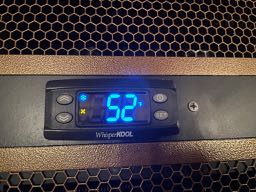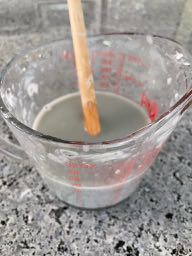Spring
The English poet John Gay once wrote that "from wine does sudden friendship spring." With May well upon us, and the start of another vintage anew, I reflected that in the fifteen years that we've been running the club there have been many friendships, some sudden, some enduring but all appreciated and valued.
We had a few conniptions woven into our winemaking activities over the winter. You may recall from the October update that our cellar air conditioner failed during the Sauvignon Blanc fermentation. Thankfully, the weather turned about the same time, and a jury-rigged fan in the newly vacated air-conditioner opening managed to keep things cool during the fall and throughout the winter. It is something of a bankrupting ordeal finding a shop that will work on small, custom air conditioners like ours, and I am now resolute in putting in a proper split HVAC system the next time we have chilling difficulties.
For the time being, we're pretty cool, tho...
And then, there was the barrel...
I may have mentioned in an earlier post that last year we had been having difficulties with a new barrel we had bought for the 2019 Cabernet Sauvignon. Let's just say if it were a ship, everyone would have been bailing pretty hard to avoid our endeavour becoming a swim club. We followed the vendor's advice and patched it full of sealing wax, waited, and even muttered a few words of prayer to any listening deity. We continued to limp (leak) along until the first racking this winter, a process where we transfer wine between between the barrels to provide oxygen exposure and an opportunity to blend. Racking relies on pressurized argon gas to push the wine out of the barrel. Pressure and leak aren't words that any winemaker wants to hear in the same sentence, and the fluid outcome cost us a case or two of wine that I sadly mopped off the cellar floor. Back to the vendor I went, strongly suggesting that they replace the barrel, which happened belatedly, although I had to cough up 1/4 of the cost. ☹️
On a more positive note, the Cabernet is progressing well. We will bottle later in the year, with a winter release on the horizon. Our second attempt at racking (with new barrel) afforded a chance to enjoy a sample that was chock full of integrated flavours, including cherry, softening tannins, and oak vanilla.
Sauvignon Blanc
We are very happy with our first Okanagan vintage in a decade, which is light, crisp and packed with melon flavours reminiscent of its New Zealand namesake. I admit, Anita and I have "sampled" a few glasses over the past month (quality assurance, you understand), and I think you will agree that this vintage is the ultimate summer sipper. We will be bottling in late June and should have it available in time for Canada Day.
Below, the story picks up again after last fall's fermentation and describes some of the key processes applied in the production of Sauvignon Blanc.
First racking took place a day after fermentation ended. Lees (dead yeast) can be seen on the sides of the fermenting tank along with precipitated crystals of tartaric acid. The hum in the background is the diaphragm pump that is used to gently transfer wine from one tank to another. The wine cellar and large parts of the basement were imbued with the aroma of Sauvignon Blanc - it was lovely!
Another look at the fermenter tank after the wine was pumped off showing about 5cm of lees deposited on the bottom. My father-in-law would have taken this fraction, put it in a carboy, and allowed it to separate further. If I had that patience, we'd have gained another litre or so of wine.
Receiving tank point of view as fresh wine arrives from the fermentor. Our rhythm for white wine making means that first racking occurs in the fall when temperatures are starting to subside. In order to take advantage of the cold (how uniquely Canadian, eh?) the tanks are placed in our patio well, outside. Over the next couple of months, when the mercury often dips below zero, the chilling effect causes tartaric acid in the wine to precipitate and cling to the walls of the tank. This cold stabilization is an important step as it lowers the overall acidity of the wine, which in the case of Sauvignon Blanc can be quite high, and also prevents the crystals from forming in the bottle later on. These harmless wine gems are sometimes mistaken by consumers as glass 😧
Second racking in late December clearly showed large amounts of tartrate crystals that were deposited during the two months spent outside. At this stage, the Sauvignon Blanc which had also clarified significantly was pumped back into the cellar for the balance of the winter.
By third racking in April, the wine began to sparkle with clarity, was almost ready to be bottled, and tasted like a finished product to be enjoyed along with the lengthening days and warming temperatures. As a product of nature, wine contains a lot of different proteins produced by the grapes and yeast. Some of these proteins (those thought to be from the grapes) are not stable in white wine and can produce haze or turbidity if the wine is warmed. In order to remove those proteins, most winemakers use a compound called bentonite.

Bentonite, a type of clay mined in Wyoming, creates a negatively charged colloid when dissolved into water and mixed into wine. Because wine proteins generally carry a positive charge, they are attracted to the bentonite, grow heavy, and gradually settle to the bottom of the tank. This process, known as fining (pronounced "fine-ing"), is essential in making white wines heat stable and preventing haze and turbidity.
Preparing bentonite for the Sauvignon Blanc involved some of Anita's measuring bowls, bentonite granules, cold water, mixing, patience and a small mess. Because the chemistry of our wine already lends itself well to stability (mostly its very low pH), I used only a small dose equating to about 1/5th of a gram for every litre of wine. Higher doses can lead to over fining the wine and stripping away important flavours and scents. The above slurry was mixed into the wine during a racking procedure several days ago. After about a month, it will have all settled, and we will be ready to bottle.
A view of the cellar with working air conditioning, barrels that don't leak, and bentonite fined Sauvignon Blanc resting in the corner tanks.
All is well!











2 comments:
Thank you for your endless effort and dedication to excellence!
Bonjour from Quebec! Merci pour la saine gestion du club, from the inception of the proposed annual blend, all the way to the finished stock. I truly enjoy assisting (as much as possible) you in this annual tradition.
Post a Comment